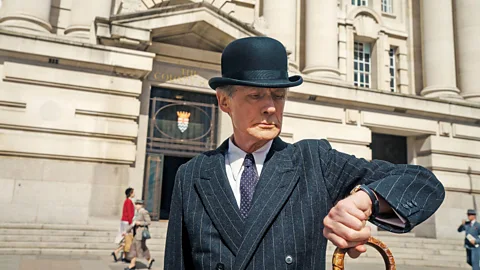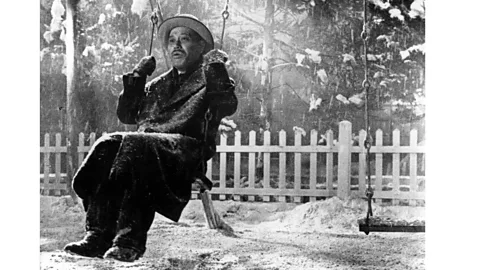Living to Breaking Bad: The film and TV facing up to death
 Lionsgate/Alamy
Lionsgate/AlamyA new remake of Akira Kurosawa's Ikiru sees a man finding peace after a cancer diagnosis. Like films and shows before it, it may help audiences face up to the inevitable, writes Leila Latif.
There are few things people like talking about less than the inevitability of death. For many, that fact exists buried in the deepest crevices of the mind, too hard even to contemplate. It makes a film like Living, which stars Bill Nighy as a civil servant in 1950s London trying to decide how to live out his final days following a terminal cancer diagnosis, a daunting prospect for some. But for the film's director Oliver Hermanus, part of the power of Living is how it rejects despair: "we're tricking the audience a little bit because they think they are on a certain journey, but the payoff is incredibly cathartic, and it's a really warm embrace. Emotionally it starts with somebody who's dead and by the end of it, it's somebody who's very much alive", he tells BBC Culture, describing the journey his protagonist Mr Williams makes as "a birth, not a death".
More like this:
While Mr Williams comes to accept, and even embrace his impermanence, western society as a whole is rife with self-delusion around mortality. "It's what Ernest Becker called the denial of death," philosopher Simon Critchley tells BBC Culture. "We live in a culture that denies death and art is a very good way to confront it, accept it and think it through." On the subject of leaving the mortal coil, Critchley has an extensive bibliography including the books Very Little… Almost Nothing: Death, Philosophy, Literature, The Book of Dead Philosophers, How to Stop Living and Start Worrying and Notes on Suicide, and holds that there is profound freedom in our acceptance of our own mortality. In motioning us towards this, films like Living can have a real part to play: for while a level of fiction cushions the blow for the existentially terrified, they can bring audiences closer to confronting what a good life and a good death means to them. The impact of such a confrontation can be profoundly beneficial: as Dr Karen Chumbley, GP and Leader of End of Life Care in Suffolk and Northeast Essex in the UK, emphasises, making "a safe space for some of those discussions" is a great thing "because it can empower the patient. Too often we sweep [death] under the carpet because we're afraid to bring it out and plan for it. Talking about it does not have to be a conversation that is held through tears, especially when it's timely. End of life sometimes has real beauty in it."
 Alamy
AlamyThat beauty is often showcased in the particular sub-genre of films, that includes Living, in which protagonists face death by really embracing life. From the tear-jerking romance of Love Story (1970) and Bright Star (2009) to the gallows humour of Last Holiday (1950) and its 2006 remake; from the sweeping drama of Melancholia (2011) and Death in Venice (1971) to the musical flights of fancy of Bob Fosse's All that Jazz and audacious action of Crank (2006) and Source Code (2011) – each of these movies considers a fundamental question: when death goes from abstract to imminent, what do we do with the time we have left? For many cinephiles, that question has never been better answered than in Akira Kurosawa's 1952 film Ikiru, of which Living is an English language remake: like Living, it concerns a bureaucrat Mr Watanabe, this time in Tokyo, who finds out he has cancer and resolves to get a children's playground built in a final effort to do something meaningful with his life.
A 'blueprint on how to live life'
Living's screenwriter, the Nobel Laureate Kazuo Ishiguro, and author of novels including Remains of The Day and Never Let Me Go, re watching Ikiru as a child and it having a big impact on him. "It helped form a blueprint for me when I was a young person on how to live life," he tells BBC Culture. Ishiguro came up with the idea for Living because he felt there could be something interesting in marrying the power of Ikiru's message around mortality "with a kind of contemplation of England and Englishness".
While changing the location of the story from Tokyo to London, Ishiguro retained Ikiru's 1950s setting for Living, such that, even if certain plot details in it no longer have the same relevancy (given the high instances of cancer in post-World War Two Japan, for example, the fact Ikiru featured a stomach cancer diagnosis was a subtly damning indictment of nuclear weapons), the backdrop of a world rebuilding itself post-World War Two is still a key, invisible element. Critchley explains that "there is a strange relationship between war and creativity, particularly philosophical creativity. War gives a strange kind of impetus to the sense that there is something which is much more important, where everything is on the line. It's a theory I [have been] toying with that you can trace back over the centuries a correlation between periods of real conflict and periods of philosophical productivity, the emergence of new things, new paradigms emerging."
For Ishiguro, the difference between Living and Ikiru is that his film is able to reflect that moment of intense reassessment with the benefit of hindsight, "I have one advantage over Kurosawa and his collaborators when writing that script," he smiles, "[which is that] they wrote it very shortly after the war and didn't know that Japanese society would in a very short period of time transform into this economic superpower and liberal democracy out of the ashes of the war, after having been a quasi-fascist state." For contemporary audiences, Kurosawa's film, with its metaphor of Mr Watanabe's triumphant building of the playground, has unwittingly become a tribute to the human spirit of the era. Similarly in Living, what is more consciously reflected is "how tremendous [it was] that a generation of British people after the war rebuilt a better Britain and a welfare state."
Aside from the location, the most significant change in Living from its source material is in the protagonists' age. In Ikiru, Mr Watanabe was played by one of Kurosawa's favourites Takashi Shimura who was then in his late forties. Nighy, by contrast, is in his early seventies. But even though the character is later on in life, Hermanus doesn't think that reduces the power of his epiphany: in fact, he says, there's "almost a feeling he's wasted more time not being switched on to life and actually living" so it "conversely creates a greater sense of urgency". Hermanus, with this film, says he has sought to create a work of art that could fuel that urgency in others, one that audiences could "reach for'' in moments of despair. He references It's a Wonderful Life (1946) as a film that he similarly finds solace in, for "providing another point of view" on existence.
 Alamy
AlamyIt has to be said not all films about people confronting death turn out to be so profound. Perhaps the most inane depictions of this struggle can be found in the surprisingly populous sub-genre of "beautiful teens with cancer" romances (Here On Earth (2000), A Walk To (2002), The Fault in Our Stars (2014) and Now is Good (2012) to name but a few). Better, if a twisted subversion of the sub-genre, is the horror franchise Saw (2004-), whose original villain was a crazed engineer diagnosed with cancer who decides to build elaborate traps to teach characters how precious life is. The Saw films are unlikely to inspire a future Nobel Laureate's life philosophy, but a surprising amount of catharsis can be gained by watching the bad guy's creepy ventriloquist's puppet congratulate those who have tunnelled through razor wire or escaped immolation with a gravelly "you are still alive. Most people are so ungrateful to be alive… but not you, not anymore".
Dying on their own
Almost as radical a treatment of a character responding to their imminent demise, with as high a body count, came in one of the greatest television shows of the 21st Century. In Breaking Bad (2008-13), creator Vince Gilligan gave mild-mannered chemistry teacher Walter White a terminal cancer diagnosis and asked two fundamental questions – "What would you do for millions of dollars">window._taboola = window._taboola || []; _taboola.push({ mode: 'alternating-thumbnails-a', container: 'taboola-below-article', placement: 'Below Article', target_type: 'mix' });
